|
We do
know, based on reports from early explorers, that
before colonization there were enormous colonies of
seabirds nesting on the island in various places,
notably around Turtle Cove on the south end of the
lagoon, and on the islands at the mouth of the
lagoon. In addition, Green and Hawksbill sea
turtles nested on the beaches. There are
annecdotal reports of flightless birds and
tortoises. However, following the usual
pattern of settlement and exploitation, these birds
and reptiles were viturally wiped out when men
arrived with rats, cats, pigs, and hungry
slaves. For example, Rickard and Bashall state
that there were no large colonies of seabirds on the
mainland of Diego Garcia in 1945. Here I would
like to point out that this sort of extinction was
not completely restricted to the arrival of
Europeans, but is well known through the evidence
available in Hawaii, Christmas Island, Easter
Island, etc., and of course we should never forget
the great Pleistocene Overkill Theory!
In the
1980s, there were plenty of sea birds too, which
nested out on the Bird Shit Islands, which formed
the "toes" of the DG foot. By 2006, the Royal
Naval Birdwatching Society reported over 4,500 nests
of boobys on Barton Point, proof that unmolested
they will re-colonize the 'mainland' of the island.
SHEARWATERS
Shearwaters
are medium sized birds with long wings which get
their name from their flight pattern over the
ocean – they tend to fly right on the deck and
‘shear’ or skim along the uplifts created over the
waves. The flight pattern is generally a
rapid flap-flap-flap, followed by a long glide on
down-curved wings. However, don’t rely on
this as a positive indication of a particular
species, since shearwaters vary their style
depending on the winds and whether they are
looking for food, migrating, etc.
Although the shearwaters in the IO
are not believed to make epic migrations,
traveling only to the Arabian Sea (which still
seems pretty epic to me), some species migrate
over 9,000 miles each way from their breeding
islands in the Southern Hemisphere to wintering
seas near the artic regions. They are also
extremely long-lived, with one Manx Shearwater
that summered in the North Atlantic known to have
lived over 55 years.
Shearwaters
are generally pelagic, meaning that they spend
most of their lives over the open ocean, and
return to land only to breed. They lay one
egg in a burrow, and only return to the nest at
night, to avoid predators. They make weird
calls to their mates when they return at night,
and on Diego Garcia, they have been heard in
trees from about dusk to midnight near their
burrows. In the “Plantation” days, the
shearwaters seemed to always nest near the
villages.
One
way to identify Shearwaters is their
nostrils. These are “tubenose”
birds. Rather than having a cere with
nostrils at the base of the upper beak, tubenose
birds have tubes ending in nostrils coming about
one-third of the way down their upper
beaks. In Shearwaters, these tubes are not
fused together, like they are with Petrels and
Fulmars).
Historically,
there
have been two species of Shearwaters known on
Diego Garcia - Audubon’s Shearwater, and the
Wedge-tailed Shearwater – and these species
breed on islands of the Chagos Bank and Peros
Banhos today. About half the burrows were
located under coconut palms, with the other half
in broad-leafed forests. These species are
commonly found breeding on the same islands
throughout their range, which includes the
Atlantic and Pacific Oceans. Symens (1996)
reported that all the discovered Audubon’s
Shearwater burrows were found intermixed in the
Wedge-Tailed colonies on the Chagos Bank and
Peros Banhos atolls.
You
will probably have a hard time seeing a
Shearwater. They only come ashore at night
during the breeding season, and you’ll probably
only know that if you hear their eerie calls in
the trees. Shearwaters are well know for
getting disoriented by artificial lighting at
night – flying to them like moths - and you may
see one on the flightline or downtown at
night. However, your most likely way to
sight these, or any of the pelagic birds, is to
get out on the open ocean (fishing, or on one of
the ships), where you may see these birds
skimming low over the waves. People pay a
lot of money to go on “Pelagic Bird Watching
Tours” so if you get the chance, go on one
there!
Audubon’s
Shearwater (Puffinus lherminieri)
Known to the
Ilois as “Riga”.
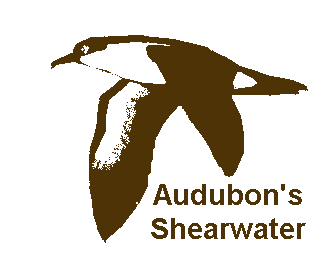 This is
the smaller of the two species on DG, with a
length from the tip of the beak to the tip of the
tail of about a foot, and a wingspan of about two
feet. The Audubon’s Shearwater is primarily
dark brown with white cheeks, a white throat and
belly, and a long dark tail with white undertail
coverts (the downy and/or small feathers covering
the rectum and extending part way down the
underside of the tail). It also has white
under-wing feathers, which look like the bird has
arms in long sleeves. This is
the smaller of the two species on DG, with a
length from the tip of the beak to the tip of the
tail of about a foot, and a wingspan of about two
feet. The Audubon’s Shearwater is primarily
dark brown with white cheeks, a white throat and
belly, and a long dark tail with white undertail
coverts (the downy and/or small feathers covering
the rectum and extending part way down the
underside of the tail). It also has white
under-wing feathers, which look like the bird has
arms in long sleeves.
There
are four subspecies generally recognized to
inhabit the Indian Ocean. You’ll only be
able to tell the difference by detailed
observation of captured birds, and/or their
dissection (although you could compare DNA to
other ‘collected’ specimens) – so don’t plan on
going that route with the wildlife protection
laws in the BIOT. The subspecies that most
probably is found on DG is P. l. nicolae, since
this is the subspecies found in the Seychelles,
Maldives and the rest of the Chagos.
They
reach sexual maturity after about eight years,
and live to be 20 or more years old. On
DG, they tend to nest in small colonies,
probably beginning after March, indicating this
is the northern hemisphere subspecies P. l.
nicolae (southern hemisphere species usually
start nesting in September). Huston (1975)
heard them calling in the trees around the
villages in April of 1971, from dusk to
midnight. He didn’t state what their call
sounded like, but the USF&WS says they make
twittering and mewing calls to let their mates
know they’re on the way to the burrow.
Both parents taking turns incubating the eggs
for up to ten days at a time, while the other
hunts at sea. Eggs take seven weeks to
hatch, and the young take about 10 weeks before
they can leave the nest.
Adult
Audubon’s Shearwaters do not wander far from the
breeding islands, nor do they take long
migrations. They also will feed in
offshore, or, in the case of DG, inshore (i.e.,
the lagoon) so you have a better opportunity to
see this species that the other shearwaters.
The
Audubon’s Shearwater can dive below the surface
from a swimming start, plunge down from above,
and even snag-while-skimming for it’s food,
which consists of the typical food of pelagic
birds – small fish, squid and ‘crustaceans’
(krill). It doesn’t follow boats and ships
looking for a handout, so if a bird is following
your boat, its probably not an Audubon’s.
Wedge-Tailed
Shearwater (Puffinus pacifica)
Known to the
Ilois as “Fouquets”. Also known at the
“Moaning Bird.”
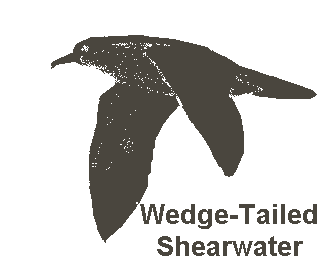 This is
the larger of the two Shearwaters that have
historically nested on DG, being about a third
bigger than the Audubon’s. It’s the size of
a crow (but not crow shaped), and has dark gray
feathers all over, a wedge-shaped tail (hence the
name) and most importantly, flesh colored legs and
feet. There is a pale morph, found mostly in
the North Pacific, but which can occur south of
the equator. The pale morph has a light grey
feathers on the underside of the body and wings. This is
the larger of the two Shearwaters that have
historically nested on DG, being about a third
bigger than the Audubon’s. It’s the size of
a crow (but not crow shaped), and has dark gray
feathers all over, a wedge-shaped tail (hence the
name) and most importantly, flesh colored legs and
feet. There is a pale morph, found mostly in
the North Pacific, but which can occur south of
the equator. The pale morph has a light grey
feathers on the underside of the body and wings.
In
1960, Wedge-Tailed Shearwaters were reported to
be breeding on “Ile de Oiseaux” (Bird Island –
one of the islands at the mouth of the lagoon),
and it has been recorded in the seas around DG
since. In 1996, Symens reported over 4,000
occupied burrows on the islands of the Chagos
Bank and Peros Banhos. If it still breeds
on DG, you should be able to tell it’s there by
its moaning calls at night – it groans, and
wails too. Typical calls are
‘ooooo-errrrr’, the oooo on the inhale, and the
errrr on the exhale.
Wedge-tailed
Shearwaters are pelagic, more so than the
Audubon’s, and probably won’t be seen offshore
or in the lagoon. They often dive for
their food, and in 2001 Burger reported they can
swim to a depth of over 200 feet to seek out
their food, which is the usual small fish, squid
and crustaceans.
The
Wedge-tailed Shearwater breeds in colonies on
small tropical islands, with Northern hemisphere
birds starting around February and southern
hemisphere birds around September. Since
DG is marginally in the Southern Hemisphere
(with nothing tropical to the south), these
birds may breed either season.
Wedge-tailed Shearwaters begin breeding at four
years, nesting in burrows, or on the surface
under some sort of cover. They are
monogamous for years at a time, and only seek
new mates if a breeding season ends in
failure. Like the Audubon’s Shearwater,
they incubate eggs in shifts, sometimes lasting
up to two weeks. The eggs hatch after
seven weeks, but fledging takes much longer than
with Audubon’s, taking 16 – 18 weeks.
TROPIC BIRDS

Red-tailed
Tropic Bird (Phaethon rubricauda).
This
is the rarest of the three species of Tropic
Bird, but is found across the Indian and Pacific
Oceans. It has been recorded from DG and
the previously inhabited islands of the Chagos,
as well as over the nearby seas. Before
the construction of ‘downtown,’ it was reported
to be common on the northwest tip of the atoll.
The
Red-tailed Tropicbird looks like a husky tern,
with white plumage, a bright red bill, black
legs and feet, and long, quill-thin red tail
feathers. The tail feathers are sometimes
not easily visible in flight against the sky,
and young Tropic Birds do not have the long tail
feathers.
Red-tailed
Tropicbirds tend to nest in large colonies on
coral atolls and islands where they typically
nest under the shrubs near the beach.
Colonies are found from Mid-Pacific to the
Mascerenes.
Because
of the destruction of the ground-nesting
seabirds on DG during the last century, they are
still very rare, but perhaps have re-established
themselves as breeders, since they wander widely
when not breeding and may have ‘re-discovered’
DG. They are pelagic, but don’t congregate
in flocks while feeding. Normally, they
‘plunge-dive’ for their prey, which is mostly
fish and squid.
Peterson
says the vocalizations are ‘a hoarse WOW’ and ‘a
raucous RAT-CHET, RAT-CHET.’
White-tailed
Tropic Bird (Phaethon lepturus).
This
is the smallest of the three species of Tropic
Birds, with a length of 15 inches and a wingspan
of almost three feet. It has white
plumage, a yellowish-orange beak, conspicuous
black patches on the upper wings, yellowish legs
and feet with black between-the-toe webbing, and
clearly visible 15 inch tail feathers.
Immature birds have no tail feathers, and black
barring across the top of the wings, instead of
the patches.
There
are five subspecies, and P. l. lepturus is the
local form in the IO. There is a
golden-yellow morph (P. l. fulvus) found on
Christmas Island (off the West Coast of
Australia). Since White-Tailed Tropic
Birds wander great distances when not breeding,
you may see these yellow morphs on DG; they’ve
been seen as far west as the Seychelles.
White-Tailed
Tropic Birds are found in the Atlantic, Pacific
and IO. Symens reported that in 1996 three
pair were engaged in courting behaviour on Diego
Garcia in 1996. Throughout their range,
the White-Tailed Tropic Bird normally nests
under brushy cover near the water, but also
nests in trees when there are numerous ground
dwelling predators (such as rats). It has
also been found nesting on abandoned buildings.
They
reach sexual maturity at four years, and nest
year round throughout their range. Like
many other sea birds, the adults take shifts
incubating the single egg, with the average
shift lasting up to a week. They have the
throat pouch and large gullets like other
pelecaniforms, but unlike pelicans and Boobies,
they feed their young by regurgitating food, and
shoving it down the chicks throat. When
the chicks are fully fleged (at about 11 weeks)
the parents abandon them, and the young birds
get so hungry they leave the nest, head for the
ocean, and teach themselves to fly and fish.
During
courtship, the birds will fly in pairs, with
streamers from the bird above turned downwards
towards it mate. Otherwise, they are
solitary feeders, who ‘plunge-dive’ to seize and
swallow their prey, which, as usual, consists of
fish and squid.
The
call is a high-pitched scream:
kee-kee-krrrt-krrt-krrt.
BOOBIES
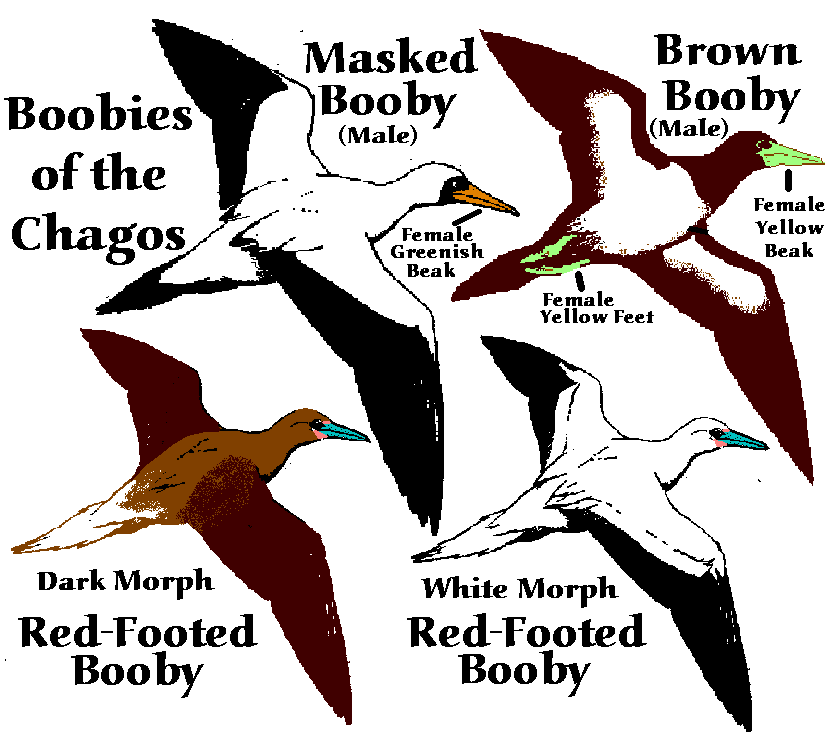
There are three species of Booby
in the Chagos: Red-footed, Masked and Brown
Boobies. The Masked and Brown Boobies nest
on islands of the Great Chagos Bank.
Although they are pelagic when not breeding, they
do not wander very far from their nesting
colonies, so you may not see Masked or Brown
Boobies during your tour on Diego Garcia.
Boobys
are member of the order Pelecaniforms, and share
many of the order’s characteristics. They
are strong fliers, but they are real boobs when it
comes to take-offs and landings; if they can, they
use headwinds and high perches to assist on
take-off. They have throat pouches and wide
gullets to allow capturing and swallowing large
fish, which they catch by diving vertically into
the water, sometimes from heights of 50 feet or
more. They also catch leaping fish while
skimming over the surface, and when seen feeding
in groups usually indicate a school of predatory
fish like Tuna are below chasing feeder fish
toward the surface.
Unlike
most other birds, they do not have brood patches
on their chests to keep their eggs warm, and
instead incubate their eggs with their
feet. They share incubation duties, but
don’t stay at sea hunting for long
periods. Their chicks feed by poking their
beaks into the gullet where the adults store
half-digested fish and squid.
It
isn’t too hard to tell the three species apart
when they are in flight. The Red-footed
Booby is smaller and faster-flying than the
other boobies, and of course has the red
feet. Masked Boobies look like white morph
Red-Footed Boobies, but have black tails, and
the black mask around the beak. Adult
Red-Footed Boobies (both morphs) have white
tails. Immature Red-footed Boobies can be
told from Brown Boobies, which have white
bellies and under-wing coverts. See the
picture above for a better idea.
Red-footed
Booby (Sula sula)
Known to
the Ilois as “Fou”.
Which
reminds me of the joke about the foo-bird…
The
Red-Footed Booby is the smallest of all boobies,
with a wingspan of a little over four and a half
feet (which is still a pretty big bird).
This species exhibits a variety of color phases,
although the “white morph” makes up the vast
majority of the individuals on DG (the “dark
morph” being predominant in the
Galapagos). This morph is white, except
for the black primary and secondary flight
feathers on each wing. The bill is light
blue while the skin around it is pink.
Like the name implies, their feet and legs are
red. Juveniles resemble the dark morph,
and are wholly brown or dark gray, with a very
dark bill, facial skin, and legs. The
rump, coverts, and tails of both white and dark
morphs are white.
Red-Footed
Boobies normally feed alone, or sometimes with
mixed flocks as they pursue the schools of fish
and squid stirred up by tuna. They’ll feed
day or night.
They
are nest builders, and build these nest on the
top of shore trees and scrub, like scaevola
(which we all called scaveola when I was
there). They’ve been know to build their
nests in coconut trees, and in the same bush as
a Frigate Bird.
Red-Footed
Boobies live for more than 20 years, and are
sexually mature at four years of age. They
are monogamous, and perform elaborate greeting
rituals, including harsh squawks and the male’s
display of his blue throat pouch. They lay
a single chalky white egg, which they incubate
in 24-hour shifts for about six weeks, when the
egg will hatch. Fledging occurs after
about 14 weeks, and the parents will continue to
care for the immature birds for up to four
additional months. It takes up to three
years before the young moult into their adult
coloration, so what may appear to be dark morphs
in a colonial area may just be immature white
morphs.
There
is a huge colony (members of the Royal Navy
Birdwatching Society claimed 4,500+ nests in
2006) of Red-Footed Boobies on the east arm of
the DG atoll, and more on the islands in the
mouth of the lagoon. This species doesn’t
necessarily follow the “northern winter” nesting
season, and seems to spread it’s breeding and
chick rearing over a long period, if not year
round. It is possible to see the colony on
the ‘mainland’ of DG, and it is worth the trip
to do so if you can get the Brits to give you a
permit. Here's a picture of a portion of
the colony:
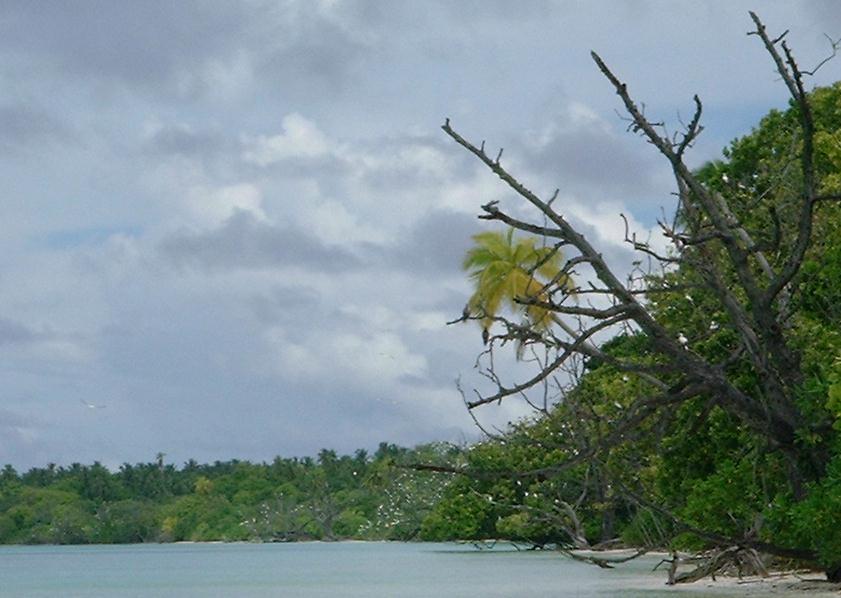
Masked Booby
(Sula dactylatra)
Also called
the “Blue-Faced Booby”.
This
is the largest of the boobies, with a wingspan of
over five feet, and is found in tropical seas
around the globe, except in the eastern Pacific
and eastern Atlantic. This booby closely
resembles the Red-Footed Booby, except that the
bill and feet are yellowish in the male (greenish
in the female), and the tail is black. It
also has a black mask around the beak, which turns
blue during the breeding season. Young birds
are grayish brown, with white undersides, develop
adult plumage after two years, and achieve sexual
maturity at four years of age. Masked
Boobies are known to live to be about 20 years
old.
The
Masked Booby nests in small colonies throughout
its range, and Symens in 1996 estimated about 250
pairs breeding on islands of the Chagos
bank. It appears that the breeding season
occurs between February and August. However,
its breeding practices are unlike those of the
Red-Footed Booby. It nests on the ground in
a simple, shallow depression, and generally lays
two eggs, about a week apart. The incubation
shifts are pretty short for Boobies, only about 10
hours. The chick of the first egg to hatch
usually kicks the second hatchling out of the nest
shortly after it hatches, and so only the oldest
chick survives. It fledges after a long
period (up to four months) and hangs out with the
parents for another couple months, learning the
ropes.
The
Masked Booby isn’t vocal when over or on the
ocean, but is heard to make a wide variety of
whistles, hisses, and quacks in the nesting
colonies.
There
are four subspecies, which cannot be distinguished
one from the other in flight. The subspecies
that nests in the Chagos is S. d. melanops.
Brown Booby
(Sula leucogaster).
The
Brown Booby is mid-way in size between the
Red-Footed and Masked Boobies, but in color is
very different, and easy to tell apart. The
adults have dark brown upper bodies, heads and
necks, with a white belly, and under-wing
coverts. The sexes have different beak and
foot colors – yellow in the females, and greenish
in the males. The juveniles are similar to
the adults, but the belly and under-wing coverts
are a light brown.
Like
the Masked Booby, it nests on the ground, but
makes a small mound of sticks and twigs for its
nest (rather than a depression). Like the
Masked Booby, it lays two eggs, and the first to
hatch shoves the second out of the nest to die,
and rarely are two young fledged. The
average incubation shift is about 12 hours for the
six weeks it takes for the egg to hatch, and the
young birds leave the nest after about 13
weeks. Like other Boobies, the youngster
hangs out with the parents for another couple
months, learning how to be a Booby.
These
birds are monogamous for several seasons at least,
and have elaborate greeting rituals on the nesting
grounds. They are reported to be silent,
although some say they quack and grunt, so if you
get up to the Chagos Bank and get to walk around
the colonies there, listen closely and let me
know.
FRIGATEBIRDS

There
are five species of Frigatebirds, two of which,
the Great Frigatebird (Fregata minor) and the
Lesser Frigatebird (F. ariel), are found on and
around Diego Garcia. In 1996, Symens
estimated there were about 2,000 Great
Frigatebirds in the Chagos, but only 85 nesting
pairs, all on islands on the Chagos Bank.
There were far fewer Lesser Frigatebirds, with
only 72 nesting pairs found, also all on the
Chagos Bank. Given the huge discrepancy
between individual Great Frigatebirds and the
number of nests, it is possible that rookeries
remain to be found. They tend to nest in the
same colony as Red-Footed Boobies, and as that
species expands its colonies on Diego Garcia, it
is probable that Frigatebirds are nesting there
now, so keep your eyes peeled.
Frigatebirds
attack other sea birds to steal their food, and
are also called Man o’ War or Pirate birds.
They are pelecaniforms, but unlike the pelican,
they cannot swim, walk to speak of, or take off
from the water or flat ground. But they do
have the largest wing-loading to body weight ratio
of any bird, and spend most of their lives in the
air over the open ocean. They stay airborne
for over a week at a time, and often ride along
weather fronts, and are useful in predicting a
change in the weather. They only land
(always in trees) to roost or attend their nests
and young.
They
are lightweight birds though they look huge
because of their wingspan, and are easy to spot
overhead – they appear almost completely
iridescent black, with long pointed wings and deep
swallow tails. They never seem to flap their
wings, and are expert at gliding and catching the
slightest updraft.
The
males have inflatable red-coloured throat pouches,
which they inflate like a huge balloon to attract
females during the mating season. They form
colonies in trees, often within a colony of
Red-Footed Boobies, and raise one chick. Both
parents take turns feeding the chick until it
fledges at about three months of age. At
that point, the male takes off and attempts to
attract a new mate to a new nest. The female
Frigatebird cares for its chick for another eight
to fifteen months, the longest adolescence of any
bird species. It’s a common sight in
Frigatebird rookeries to see a full-grown chick
over a year old, larger than its mother, land on
the nest and scream to be fed. It takes so
long to rear her chick that female Frigatebirds
breed only every other year.
Frigatebirds
are pelagic feeders, and use their long, hooked
beaks to snatch most of their food (primarily
flying fish) from the ocean surface. They
also rob other seabirds of their prey, even
harrassing Boobies to the point where the Booby
regurgitates, which the Frigatebird can catch in
the air, or snatch off the ocean surface.
Great
Frigatebird (Fregata minor)
Known to the
Ilois as “Fregat”
The
Great Frigatebird is a common sight overhead Diego
Garcia, and several hundred live in the trees over
on the east tip of the atoll and on the islands in
the mouth of the lagoon. Although they can
and do travel vast distances over the open ocean,
they tend to spend most of their lives within 50
miles of their breeding colonies, and since they
live to over 30 years old, it’s possible the birds
you see overhead DG today are the same ones I saw
there 25 years ago.
Great
Frigatebirds weigh between 2-3 pounds, and have
wingspans of seven and a half feet. Females
are generally larger than the males. In
coloration, the females are black with a white
breast and throat. The males are iridescent
black and the red throat pouch is often visible on
flying birds. Young Great Frigatebirds have
yellowish or whitish heads and throats.
Great
Frigatebirds reach sexual maturity at nine years
of age. Since the male participates only in
the procreation, incubation, and first few months
of chick rearing, they abandon their mates and
young, and try to breed every year. After
staking out a promising tree top, the males
inflate the red throat pouch, spread their wings,
and shake their heads from side to side at every
female they see. After a female accepts his
advances, it takes anywhere from a few days to a
few weeks to construct a platform nest of sticks
and beach junk, and after the egg is laid, the
parents incubate the egg for about eight weeks in
three to six day shifts, during which they loose
25-33% of their body weight.
In
addition to the extraordinarily long period the
mother cares for her chick, young Great
Frigatebirds are known to play with other
adolescents. One bird will pick up a stick
or piece of flotsam and the other hoodlums will
give chase until the stick is dropped, with the
whole flock trying to catch the stick before it
hits the water. They don’t seem to tire of
this game, and it probably teaches the skills they
will need to snag their food off the ocean
surface, and to steal other birds’ food.
Great
Frigatebirds will also hunt seabird chicks at
their breeding colonies, taking mostly the chicks
of tree-nesting terns and noddies.
Lesser
Frigatebird (Fregata ariel)
Known to the
Ilois as "Pti Fregat".
The
Lesser Frigatebird is like a smaller version of
the Great Frigate, and indistinguishable in flight
when at high altitude. However, when they
are clearly visible to the naked eye or a powerful
set of binoculars, it can be seen that Lesser
Frigatebirds have white markings extending onto
the undersides of each wing. The females
also have a white breast. Like Great
Frigates, juveniles have a white or pale buff
head.
As
noted earlier, there are far fewer Lesser
Frigatebirds in the area, and all of those seen in
1996 were on the Chagos Bank. But keep a
close watch for these overhead DG, as the
environment on Diego improves for breeding
colonies of seabirds.
|
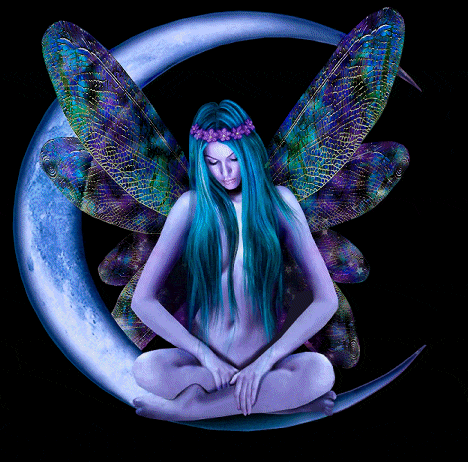
 This is
the smaller of the two species on DG, with a
length from the tip of the beak to the tip of the
tail of about a foot, and a wingspan of about two
feet. The Audubon’s Shearwater is primarily
dark brown with white cheeks, a white throat and
belly, and a long dark tail with white undertail
coverts (the downy and/or small feathers covering
the rectum and extending part way down the
underside of the tail). It also has white
under-wing feathers, which look like the bird has
arms in long sleeves.
This is
the smaller of the two species on DG, with a
length from the tip of the beak to the tip of the
tail of about a foot, and a wingspan of about two
feet. The Audubon’s Shearwater is primarily
dark brown with white cheeks, a white throat and
belly, and a long dark tail with white undertail
coverts (the downy and/or small feathers covering
the rectum and extending part way down the
underside of the tail). It also has white
under-wing feathers, which look like the bird has
arms in long sleeves.
 This is
the larger of the two Shearwaters that have
historically nested on DG, being about a third
bigger than the Audubon’s. It’s the size of
a crow (but not crow shaped), and has dark gray
feathers all over, a wedge-shaped tail (hence the
name) and most importantly, flesh colored legs and
feet. There is a pale morph, found mostly in
the North Pacific, but which can occur south of
the equator. The pale morph has a light grey
feathers on the underside of the body and wings.
This is
the larger of the two Shearwaters that have
historically nested on DG, being about a third
bigger than the Audubon’s. It’s the size of
a crow (but not crow shaped), and has dark gray
feathers all over, a wedge-shaped tail (hence the
name) and most importantly, flesh colored legs and
feet. There is a pale morph, found mostly in
the North Pacific, but which can occur south of
the equator. The pale morph has a light grey
feathers on the underside of the body and wings.


